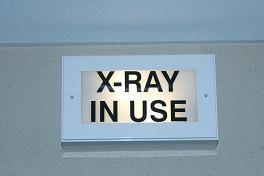
At the most basic level, x-ray machines function by sending a concentrated stream of x-rays through the body part undergoing an image. This stream is blocked by calcium in a patient’s bones, allowing only some of the radiation to imprint upon an x-ray detector. Contrast generated by the blockage results in an image which can help diagnose trouble spots.
Until the 1990’s the vast majority of X-Ray systems utilized film as a medium for a patient’s images. In principle these systems worked somewhat like traditional film cameras. Radiation imprints the image directly onto photographic x-ray film. Unfortunately, hazardous chemicals were required to process the film in a dark room. Furthermore processing took many minutes and there was much allowance for error.
Enter computed radiography. In CR systems, a layer of phosphor takes the place of X-Ray film. After exposure to radiation, a semi-stable image is imprinted into the phosphor inside a cassette. This is then read by a dedicated scanner and imported into a computer. The phosphor must be properly erased after each exposure. While CR systems have numerous upsides, the scanning and erasing process still takes significant time. Additionally, image quality is typically degraded after writing and reading the layer of phosphor.
One of the most advanced X-Ray technologies today is direct radiography. A direct digital detector takes the place of the CR cassette. These systems forego the computed radiography read and erase steps, reducing the noise level and typically increasing dynamic range. The result is often a higher quality image which can assist the physician in a proper diagnosis.
At Onto Orthopedics, we recently made the jump to one of the latest direct radiography systems. Don’t settle for the limitations of traditional film or computed radiography at many other practices.
http://www.icrco.com/en-us/solutions/orthopaedic-solutions.html
Related Posts
Cigarettes May Inhibit Inflammation Treatments
Axial spondyloarthritis, also known as AxSpa, is a chronic…






